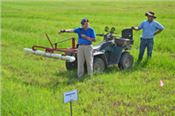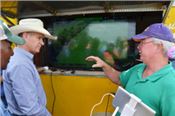|
Body Condition Scores Reflect Cattle Fitness

Larry Thibodeaux, St. Martin Parish Cattlemen’s Association president,
explains how he made a wiper bar to apply glyphosate to remove undesirable
grasses and weeds in pastures.
Photos by Bruce Schultz
BREAUX BRIDGE, LA.
Regular evaluation of individual cows and bulls in a herd will increase efficiency and profits, cattle producers were advised at the St. Martin Parish cattle field day held June 18.
Stan Dutile, LSU AgCenter county agent in Lafayette Parish, said the regular use of body condition scoring will reveal which animals are not maintaining proper weight.
“Cattle need to be in good shape or in moderate shape to rebreed quickly,” Dutile said.
Thin cows will produce less colostrum, the special milk produced in the first days after birth, so the calves will not be as healthy as those from cows with higher BCS numbers, he said.
Dutile said the target BCS should be 5 to 6 out of 9, and cows that fall in that range usually are able to breed within 55 days.
Determining BCS of cows 90 days before calving provides enough time to increase their weight, he said.
AgCenter ruminant nutritionist Guillermo Scaglia said vaseygrass provides good nutrition before it develops a seed head.
The protein level of 9.2 percent and 56 percent total digestible nutrients in a vaseygrass and bermudagrass hay sample is adequate for pregnant dry cows, but more nutrition will be needed for lactating cows, Scaglia said.
Stuart Gauthier, LSU AgCenter county agent in St. Martin Parish, showed results of a test using glyphosate to kill vaseygrass and dallisgrass on the Sammy Broussard ranch where the field day was held.
Gauthier said an 8-to-10-ounce rate per acre will allow bermudagrass to grow back quickly.
Larry Thibodeaux, St. Martin Parish Cattlemen’s Association president, demonstrated the use of a homemade wiper bar attached to a four-wheeler to apply glyphosate to undesired vegetation.
Mike Dominique, of Dominique’s Livestock Market, said he’s not sure how long lower cattle prices will prevail. “Two weeks ago, we thought we’d leveled off and found the bottom,” He said. “I’m not comfortable saying we have found the bottom yet.”
Cattle buyers are trying to compensate for earlier losses. Calves that brought $1,050 a head in 2015 are now selling for $640, he said.
Larger calves that have been vaccinated will bring better prices, Dominique said.
It’s a good time to cull older cows and to keep heifers. “Get ready for the next cycle that’s coming,” he said. ∆

LSU AgCenter agricultural engineer Randy Price, right, tells Sammy Broussard
about the practical applications of a drone to monitor a cattle operation.
Broussard’s ranch near Cypress Island was the setting for the St. Martin Parish
cattle field day on June 18.
|
|